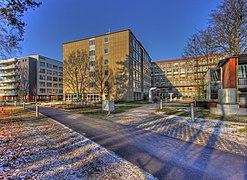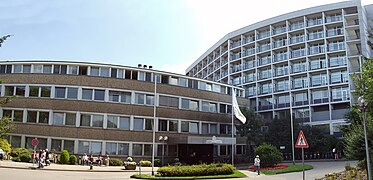Benno Schachner
Benno Schachner (born January 20, 1902 in Freising ; † 1987 ) was a German architect .
Live and act
The son of the Munich architect Richard Schachner studied architecture with Theodor Fischer at the Technical University of Munich from 1921 to 1925 and completed his legal clerkship with Robert Vorhoelzer at the Bavarian Post Construction School until 1927 . Benno Schachner then worked as a freelance architect for his father, gaining experience primarily in hospital construction.
In 1932, Schachner moved to RWTH Aachen University , where he completed his habilitation and was given a teaching position for the subject of "Technical Expansion" with a focus on new hospital construction. During the time of National Socialism , Schachner developed into a pronounced follower of the system and in 1933 initially joined the SA . Because of this membership, he was particularly encouraged by the faculty and the ministry and was then awarded in 1936 in addition to his actual field of "agricultural building". A year later Schachner became a member of the NSDAP and in 1938 was appointed full professor. In the same year he married the mineralogist Doris Schachner, b. Grain .
After parts of the RWTH were to be closed or outsourced at the beginning of the Second World War , he was transferred to the German Technical University in Brno in 1939 to take over the chair for building construction . In 1940 he was followed by his wife, who was the only female employee to receive a teaching position at the mineralogical institute there. Their daughter Melitta Schachner was born in Brno in 1943 , who later became Professor of Neurobiology at the Center for Molecular Neurobiology Hamburg at the University of Hamburg .
After the war, Benno Schachner and his family returned to Aachen, where, following the hearing by the military government as part of the denazification process , he was taken on by RWTH Aachen University from 1946, initially as a visiting professor and later as a full professor for agricultural and hospital construction. In 1968, together with his wife and many other professors from RWTH Aachen University, he was one of the signatories of the “ Marburg Manifesto ”, which formed an academic front against the emerging co-determination at universities.
Buildings (selection)
- 1930s: Urban planning for Heimbach
- 1948/1949: Reichswaldsiedlung Kleve
- 1953–1956: Leverkusen Municipal Hospital, since 1980 academic teaching hospital at the University of Cologne
- 1957: Preliminary planning for the Wilhelmshaven Clinic
- 1957–1963: Municipal children's hospital in Cologne-Riehl with a fountain system made up of four exposed aggregate concrete basins
- 1959–1961: Children's Clinic of the City Hospitals Aachen ; already demolished in the 1980s
- 1970–1972: New construction of the main building at Luisenhospital Aachen
- 1971–1983: New construction of the Aachen University Hospital together with the architectural office Weber, Brand & Partner
Fonts (selection)
- Hospital construction in key words and sketches , Callwey, Munich, 1935
- Hospital construction: attempt to develop from today's public health care requirements to structural design , Triltsch, Würzburg 1937
literature
- Ulrich Kalkmann: The Technical University of Aachen in the Third Reich (1933–1945) ; Volume 4 of the Aachen Studies on Technology and Society ; Mainz 2003, S377 and others ( digitized )
Web links
- Benno Schachner. In: arch INFORM . (Short biography)
- Short biography in: Marco Kieser: Heimatschutzarchitektur in the reconstruction of the Rhineland , Cologne 1998
Individual evidence
- ↑ Wording and list of signatures of the manifesto against the politicization of universities ( memento of the original from July 4, 2018 in the Internet Archive ) Info: The archive link was inserted automatically and has not yet been checked. Please check the original and archive link according to the instructions and then remove this notice. , in: Blätter für German and international politics , born in 1968; Issue 8
- ^ Marburg Manifesto , in: Der Spiegel of July 22, 1968
- ↑ Jan Sting: Health Park Clinic is now an oasis , in: Leverkusener Anzeiger from September 18, 2013
| personal data | |
|---|---|
| SURNAME | Schachner, Benno |
| BRIEF DESCRIPTION | German architect |
| DATE OF BIRTH | January 20, 1902 |
| PLACE OF BIRTH | Freising |
| DATE OF DEATH | 1987 |



